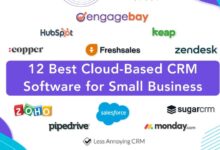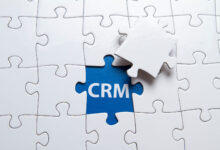CRM for Sales and Marketing Automation
CRM for Sales and Marketing Automation represents a powerful synergy, streamlining processes and boosting efficiency for both sales and marketing teams. By integrating these crucial business functions, companies can achieve a more unified approach to customer relationship management, leading to improved lead nurturing, enhanced customer engagement, and ultimately, increased revenue. This exploration delves into the core functionalities, benefits, and considerations involved in implementing a successful CRM system for sales and marketing automation.
This integrated approach allows for a more holistic understanding of the customer journey, enabling businesses to personalize interactions and optimize their strategies across the entire sales funnel. From lead scoring and opportunity management to targeted email campaigns and performance analytics, a unified CRM offers a comprehensive suite of tools designed to enhance productivity, drive growth, and foster stronger customer relationships.
Defining CRM for Sales and Marketing Automation
A Customer Relationship Management (CRM) system, when integrated with marketing automation capabilities, becomes a powerful tool for businesses to manage customer interactions across the entire sales and marketing funnel. This unified approach streamlines processes, improves efficiency, and ultimately drives revenue growth. It’s more than just a contact database; it’s a central hub for all customer-related data and activities.
Core Functionalities of a Sales and Marketing CRM
A CRM system designed for both sales and marketing encompasses a wide range of functionalities. Core features typically include contact management (centralized storage and organization of customer data), lead management (tracking and nurturing leads through the sales pipeline), sales pipeline management (visualizing and managing the progress of sales opportunities), marketing automation (automating repetitive marketing tasks such as email campaigns and social media posting), reporting and analytics (tracking key metrics to measure performance), and customer service capabilities (managing customer inquiries and resolving issues). The integration of these functionalities allows for a seamless flow of information between sales and marketing teams, leading to improved collaboration and increased efficiency.
Differences Between Sales-Only and Integrated CRMs
The key difference lies in the level of marketing automation integration. A sales-only CRM primarily focuses on managing the sales process, tracking deals, and managing customer interactions within the sales cycle. An integrated CRM, however, extends these capabilities by incorporating marketing automation features. This allows for the automation of marketing tasks, lead scoring and nurturing, and campaign tracking, providing a holistic view of the customer journey from initial contact to final sale and beyond. A sales-only CRM lacks the ability to effectively manage and nurture leads before they become sales opportunities, while an integrated CRM provides a complete solution.
Benefits of a Unified CRM for Sales and Marketing Teams
Using a unified CRM offers significant advantages to both sales and marketing teams. Sales teams benefit from a constant stream of qualified leads generated through targeted marketing campaigns, leading to improved conversion rates and increased sales. Marketing teams gain valuable insights into the effectiveness of their campaigns based on sales data, allowing for data-driven optimization and improved ROI. Furthermore, a single source of truth eliminates data silos and ensures consistency in messaging and customer experience across all touchpoints. For example, a marketing campaign could identify potential high-value customers, which are then automatically routed to the appropriate sales representative, leading to a more efficient and effective sales process. This eliminates duplicated effort and improves overall team productivity.
Comparison of CRM Platforms
Below is a comparison of three popular CRM platforms, highlighting their sales and marketing automation capabilities:
| Feature | Salesforce Sales Cloud | HubSpot CRM | Microsoft Dynamics 365 |
|---|---|---|---|
| Contact Management | Excellent; robust features, customizable fields | Good; user-friendly interface, easy to use | Good; integrates well with other Microsoft products |
| Lead Management | Excellent; lead scoring, routing, and nurturing capabilities | Excellent; robust lead scoring and nurturing features | Good; lead management tools integrated with sales pipeline |
| Marketing Automation | Excellent; extensive automation features, email marketing, etc. | Excellent; strong marketing automation features, built-in | Good; integrates with marketing automation platforms like Marketo |
| Sales Pipeline Management | Excellent; visual dashboards, forecasting tools | Good; clear visualization of sales pipeline | Good; robust pipeline management with reporting features |
Sales Automation Features within a CRM
Sales automation, a core component of modern CRMs, significantly boosts sales team efficiency and productivity by streamlining repetitive tasks and freeing up valuable time for strategic activities. By automating various aspects of the sales process, businesses can improve sales performance, enhance customer relationships, and ultimately drive revenue growth. This section will delve into key sales automation features and their impact.
Impact of Sales Automation on Sales Team Productivity
Automating tasks like data entry, lead qualification, and follow-up communication allows sales representatives to focus on higher-value activities such as building relationships with prospects and closing deals. This increased focus on strategic selling leads to improved conversion rates and faster sales cycles. For example, a sales team previously spending 20% of their time on administrative tasks could see a significant boost in productivity by reducing this to 5% through automation, allowing them to dedicate more time to engaging with potential clients. The result is a more engaged and motivated sales team, leading to increased revenue and improved overall performance.
Lead Scoring, Opportunity Management, and Sales Forecasting
Lead scoring automatically assigns values to leads based on predefined criteria such as demographics, engagement levels, and website activity. This helps sales teams prioritize high-potential leads, ensuring that resources are allocated effectively. Opportunity management involves tracking the progress of each sales opportunity, from initial contact to closing the deal. This provides valuable insights into the sales pipeline and helps identify potential bottlenecks or risks. Sales forecasting uses historical data and current pipeline information to predict future revenue. Accurate forecasting is crucial for strategic planning and resource allocation. For instance, a CRM might predict a 15% increase in sales for Q4 based on current opportunity values and historical conversion rates, allowing the company to adjust staffing or marketing budgets accordingly.
Workflow for Lead Nurturing and Conversion
Imagine a sales team using a CRM to manage leads. A new lead enters the system, automatically triggered by a website form submission. The CRM then scores the lead based on pre-defined criteria (e.g., job title, company size, website engagement). High-scoring leads are immediately routed to a sales representative for a personalized outreach. Lower-scoring leads are automatically enrolled in a nurturing campaign, receiving a series of targeted emails and other content designed to educate them and move them further down the sales funnel. As leads engage with the nurturing content, their scores increase, triggering automated follow-up actions by the sales team. This iterative process continues until the lead is either converted into a customer or deemed unqualified. This automated nurturing process significantly increases the likelihood of conversion while freeing up sales representatives to focus on high-potential leads.
Examples of Sales Reports and Their Business Value
CRMs generate a variety of reports that provide valuable insights into sales performance. Examples include:
- Sales Pipeline Report: Visualizes the progress of opportunities at each stage of the sales process, highlighting potential bottlenecks and areas for improvement.
- Lead Source Report: Identifies the most effective channels for generating leads, allowing businesses to optimize their marketing efforts.
- Sales Conversion Rate Report: Tracks the percentage of leads that convert into customers, providing insights into the effectiveness of sales strategies.
- Sales Representative Performance Report: Measures the performance of individual sales representatives, identifying top performers and areas needing improvement.
These reports provide data-driven insights that enable businesses to make informed decisions, optimize their sales processes, and improve overall sales performance. For example, a low conversion rate from a specific lead source might indicate a need to refine the marketing message or targeting strategy for that channel.
Marketing Automation Features within a CRM
A CRM system enhanced with marketing automation capabilities significantly streamlines marketing and sales processes, fostering a more efficient and effective approach to customer relationship management. These integrated tools allow businesses to automate repetitive tasks, personalize customer interactions, and gain valuable insights into campaign performance. This ultimately leads to improved lead nurturing, increased conversion rates, and stronger customer relationships.
Marketing automation features within a CRM system extend beyond simple email blasts. They encompass a range of functionalities designed to nurture leads, segment audiences, and personalize communication at scale. This allows for a more strategic and data-driven approach to marketing, optimizing resource allocation and improving ROI.
Key Marketing Automation Features Integrated within a CRM
The core functionality of marketing automation within a CRM often includes email marketing, lead scoring and nurturing, campaign management, and analytics dashboards. These features work in concert to provide a comprehensive view of the customer journey and facilitate targeted interventions at various touchpoints. Further sophistication can include social media integration, A/B testing capabilities, and advanced segmentation based on various customer attributes.
Email Marketing Campaigns: CRM versus Dedicated Email Marketing Platform
Managing email marketing campaigns within a CRM offers a centralized view of customer interactions, allowing for more personalized and contextually relevant messaging. A dedicated email marketing platform, on the other hand, often provides more advanced features for email design, deliverability optimization, and sophisticated automation workflows. The choice depends on the business’s needs and resources; smaller businesses might find a CRM’s integrated email marketing sufficient, while larger enterprises with complex email strategies might benefit from a dedicated platform. A CRM integrates email marketing directly with customer data, leading to more personalized messaging based on past interactions and purchase history. In contrast, a dedicated email platform often requires more manual data integration, potentially leading to less personalized communication.
Creating a Targeted Marketing Campaign Using CRM Marketing Automation Tools
A typical targeted marketing campaign using CRM marketing automation tools unfolds in a structured manner.
- Define Target Audience: Identify your ideal customer profile (ICP) based on demographics, firmographics, behavior, and engagement history within your CRM.
- Segment Your Audience: Divide your target audience into smaller, more homogeneous segments based on shared characteristics. This allows for more personalized messaging and increased campaign effectiveness.
- Develop Campaign Messaging: Craft compelling and relevant messaging tailored to each segment’s unique needs and interests. This ensures resonance and higher engagement rates.
- Choose Marketing Channels: Select the appropriate channels to reach your target segments (email, social media, etc.). Your CRM’s automation tools will facilitate the distribution across chosen channels.
- Set up Automation Workflows: Define the automated sequence of actions (e.g., email triggers, lead scoring adjustments) that will guide the customer journey based on their interactions with your campaign.
- Monitor and Analyze Results: Track key metrics (open rates, click-through rates, conversions) to assess campaign performance and make necessary adjustments for future campaigns.
Marketing Automation’s Contribution to Lead Generation and Customer Acquisition
Marketing automation significantly enhances lead generation and customer acquisition by automating repetitive tasks, personalizing communications, and providing valuable insights into customer behavior. For example, automated email sequences can nurture leads through the sales funnel, increasing the likelihood of conversion. Lead scoring helps prioritize high-potential leads, allowing sales teams to focus their efforts effectively. Furthermore, the data collected through marketing automation provides valuable feedback for refining future campaigns, ultimately leading to a higher return on investment. Consider a B2B SaaS company using marketing automation to send personalized email sequences to website visitors who downloaded a whitepaper. By segmenting leads based on their engagement with the email series, the company can prioritize high-potential leads for sales follow-up, resulting in a significant increase in qualified leads and customer acquisition.
Integration and Data Management
A unified view of customer interactions is crucial for effective sales and marketing. Integrating data from various sources into your CRM system allows for a holistic understanding of your customer base, enabling more targeted campaigns and improved sales processes. Effective data management within the CRM is essential for maintaining data accuracy and ensuring the reliability of your insights.
Data integration between sales and marketing teams within a CRM system fosters a collaborative environment and eliminates data silos. This integrated approach enables sales teams to access relevant marketing campaign data, such as lead scores and engagement levels, to prioritize their efforts. Conversely, marketing teams can leverage sales data, including deal sizes and conversion rates, to optimize their campaigns and improve their ROI. This bidirectional flow of information ensures alignment and maximizes the efficiency of both departments.
Data Cleansing and Accuracy
Maintaining accurate data is paramount for the success of any CRM strategy. Data cleansing involves identifying and correcting or removing inaccurate, incomplete, irrelevant, or duplicated data. This process typically involves several steps: data profiling to understand the current state of the data, data standardization to ensure consistency in formatting and terminology, deduplication to eliminate duplicate records, and data validation to verify the accuracy of the remaining data. Regular data cleansing, often automated through CRM features, is essential to ensure the ongoing reliability of the system’s insights and predictions. For example, a company might use automated rules to flag potentially duplicate contacts based on similar email addresses or phone numbers, allowing for manual review and merging or deletion as appropriate.
Consolidation of Data from Various Sources
A modern CRM system can integrate data from a wide array of sources. This includes marketing automation platforms (for lead scoring and campaign performance), customer support systems (for interaction history and feedback), e-commerce platforms (for purchase history and product preferences), and social media (for social engagement and sentiment analysis). For instance, a company might integrate its e-commerce platform data to show the CRM which products a customer has purchased, allowing sales representatives to offer relevant upsells or cross-sells. Similarly, integrating social media data can provide insights into customer sentiment and preferences, informing marketing campaigns and sales strategies.
Data Flow and Integration within a CRM
| Data Source | Data Type | Integration Method | CRM Destination |
|---|---|---|---|
| Marketing Automation Platform | Lead scores, campaign engagement | API Integration | Lead/Contact records |
| E-commerce Platform | Purchase history, product preferences | API Integration or File Import | Customer profiles |
| Customer Support System | Interaction history, customer feedback | API Integration | Case records, contact notes |
| Sales Team (Manual Entry) | Sales opportunities, deal stages | Manual data entry | Opportunity records |
Reporting and Analytics
A robust CRM system is not just about storing customer data; its true power lies in the ability to analyze that data and extract actionable insights. Effective reporting and analytics within a CRM provide a clear picture of sales and marketing performance, enabling data-driven decision-making for improved efficiency and growth. This section will explore key performance indicators (KPIs), dashboard design, and the application of CRM analytics for strategic improvement.
Key Performance Indicators (KPIs) in CRM
Understanding key performance indicators is crucial for monitoring the effectiveness of sales and marketing efforts. Tracking the right KPIs allows businesses to identify strengths, weaknesses, and areas needing immediate attention. These metrics offer a quantifiable measure of progress towards business objectives.
- Sales KPIs: Examples include conversion rates (leads to opportunities, opportunities to closed-won deals), average deal size, sales cycle length, revenue generated per sales representative, and customer lifetime value (CLTV).
- Marketing KPIs: These might include website traffic, lead generation rates, marketing campaign ROI (return on investment), email open and click-through rates, social media engagement, and cost per lead (CPL).
- Combined KPIs: Some KPIs bridge sales and marketing, such as marketing qualified leads (MQLs) converted to sales qualified leads (SQLs), and the number of customers acquired through specific marketing channels.
Sales Conversion and Marketing Campaign Performance Dashboard
A well-designed dashboard provides a visual overview of key metrics, facilitating quick identification of trends and potential problems. Below is an example of a dashboard visualizing sales conversion and marketing campaign performance.
| Metric | Current Value | Target Value | Trend (Up/Down/Stable) |
|---|---|---|---|
| Leads Generated (Marketing) | 1500 | 2000 | Up |
| Conversion Rate (Leads to Opportunities) | 25% | 30% | Stable |
| Conversion Rate (Opportunities to Closed-Won) | 40% | 50% | Down |
| Average Deal Size | $5000 | $6000 | Stable |
| Marketing ROI | 150% | 200% | Down |
| Customer Acquisition Cost (CAC) | $100 | $80 | Up |
This dashboard provides a snapshot of key performance areas. The “Trend” column immediately highlights areas requiring attention, such as the declining conversion rate from opportunities to closed-won deals and the decreasing marketing ROI.
Identifying Areas for Improvement Using CRM Analytics
CRM analytics goes beyond simply tracking KPIs; it involves analyzing the data to identify patterns, trends, and areas needing improvement. For instance, a low conversion rate from leads to opportunities might indicate a problem with lead qualification or nurturing processes. Analyzing customer demographics and buying behavior can help tailor marketing messages and sales approaches for better results. Similarly, analyzing sales cycle length can reveal bottlenecks in the sales process, allowing for process optimization and improved efficiency.
CRM Reporting and Informed Decision-Making
Regular CRM reporting provides the necessary data for informed decision-making. By tracking key metrics over time, businesses can monitor the effectiveness of their strategies, identify areas for improvement, and measure the impact of changes implemented. This data-driven approach allows for proactive adjustments to sales and marketing strategies, leading to increased efficiency, higher conversion rates, and ultimately, business growth. For example, a report showing a decline in customer retention might prompt a review of customer service processes or the development of loyalty programs.
Choosing the Right CRM System
Selecting the optimal CRM system for sales and marketing automation is crucial for business success. A poorly chosen system can lead to inefficiencies, data silos, and ultimately, lost revenue. Careful consideration of various factors ensures a smooth implementation and maximizes the return on investment.
Factors to Consider When Selecting a CRM
Several key factors influence the choice of a CRM system. Budget constraints often dictate the scope of features and functionality available. Scalability is paramount, ensuring the system can adapt to future growth in terms of users, data volume, and operational complexity. Seamless integration with existing software, such as marketing automation platforms, accounting systems, and e-commerce platforms, is essential for efficient data flow and process optimization. Finally, the system’s user-friendliness and ease of adoption by the sales and marketing teams significantly impacts its effectiveness. A system that is difficult to navigate will lead to low adoption rates and hinder productivity. For example, a small startup with limited resources might prioritize a cost-effective cloud-based solution with essential features, while a large enterprise might require a highly customizable, scalable on-premise system with advanced analytics capabilities.
Essential CRM Features Checklist
Before embarking on a CRM selection process, creating a checklist of essential features is vital. This checklist should reflect the specific needs of the sales and marketing teams. Features to consider include contact management, lead management, sales pipeline visualization, opportunity tracking, marketing campaign management, email marketing integration, reporting and analytics dashboards, and customer support functionalities. The checklist should also account for desired integrations with other business applications. For instance, a sales team might prioritize features that streamline the sales process, such as automated email sequences and sales forecasting tools. Meanwhile, the marketing team might focus on features that enable personalized email campaigns and detailed campaign performance analysis.
Implementing a New CRM System and Managing the Transition
Implementing a new CRM system involves a phased approach. First, a thorough needs assessment should be conducted to define specific requirements and objectives. This is followed by selecting a suitable vendor and system configuration. Then, data migration from existing systems is crucial, requiring careful planning and execution to minimize data loss and ensure data integrity. Next, user training is paramount, ensuring all users understand the system’s functionality and can effectively utilize its features. Finally, ongoing monitoring and optimization are essential to refine processes and address any challenges that arise during the transition. Effective change management strategies, including communication and stakeholder engagement, are key to a smooth transition and user adoption. A well-defined implementation plan, including timelines and responsibilities, can help ensure a successful transition.
Cloud-Based versus On-Premise CRM Solutions
The choice between cloud-based and on-premise CRM solutions depends on various factors.
| Feature | Cloud-Based CRM | On-Premise CRM |
|---|---|---|
| Cost | Generally lower upfront costs, subscription-based model | Higher upfront investment, ongoing maintenance costs |
| Scalability | Easily scalable, adapts to changing business needs | Requires significant planning and investment for scalability |
| Accessibility | Accessible from anywhere with an internet connection | Limited to internal network access |
| Maintenance | Vendor handles maintenance and updates | Requires dedicated IT resources for maintenance and updates |
Final Wrap-Up
Ultimately, successful CRM for Sales and Marketing Automation hinges on selecting the right platform, integrating data effectively, and leveraging the powerful analytics available to inform strategic decision-making. By aligning sales and marketing efforts through a centralized system, businesses can unlock significant improvements in efficiency, customer engagement, and overall business performance. The journey towards optimized customer relationships starts with a well-planned and effectively implemented CRM strategy.





